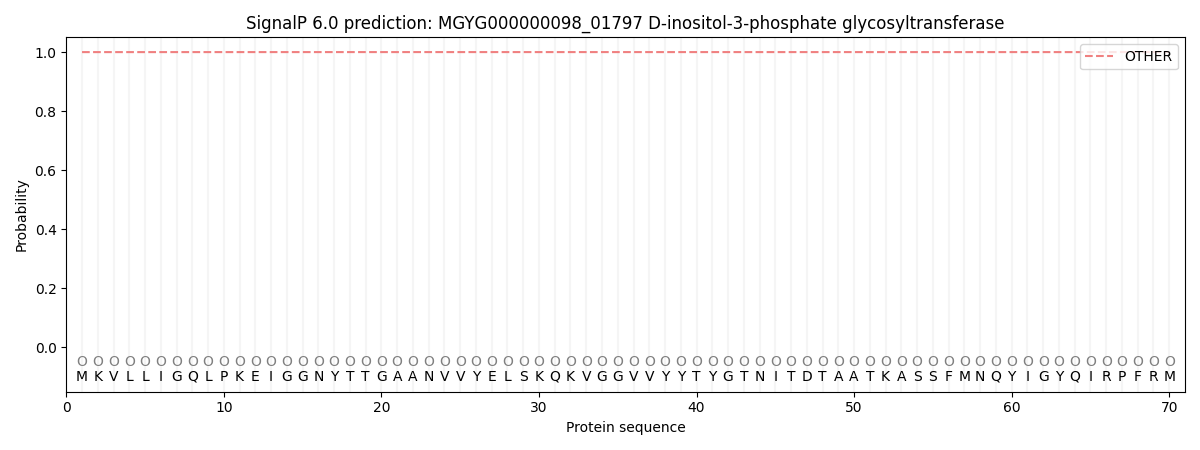You are browsing environment: HUMAN GUT
CAZyme Information: MGYG000000098_01797
You are here: Home > Sequence: MGYG000000098_01797
Basic Information |
Genomic context |
Full Sequence |
Enzyme annotations |
CAZy signature domains |
CDD domains |
CAZyme hits |
PDB hits |
Swiss-Prot hits |
SignalP and Lipop annotations |
TMHMM annotations
Basic Information help
| Species | Bacteroides bouchesdurhonensis | |||||||||||
|---|---|---|---|---|---|---|---|---|---|---|---|---|
| Lineage | Bacteria; Bacteroidota; Bacteroidia; Bacteroidales; Bacteroidaceae; Bacteroides; Bacteroides bouchesdurhonensis | |||||||||||
| CAZyme ID | MGYG000000098_01797 | |||||||||||
| CAZy Family | GT4 | |||||||||||
| CAZyme Description | D-inositol-3-phosphate glycosyltransferase | |||||||||||
| CAZyme Property |
|
|||||||||||
| Genome Property |
|
|||||||||||
| Gene Location | Start: 56892; End: 58076 Strand: - | |||||||||||
CDD Domains download full data without filtering help
| Cdd ID | Domain | E-Value | qStart | qEnd | sStart | sEnd | Domain Description |
|---|---|---|---|---|---|---|---|
| cd03801 | GT4_PimA-like | 4.80e-33 | 104 | 389 | 72 | 366 | phosphatidyl-myo-inositol mannosyltransferase. This family is most closely related to the GT4 family of glycosyltransferases and named after PimA in Propionibacterium freudenreichii, which is involved in the biosynthesis of phosphatidyl-myo-inositol mannosides (PIM) which are early precursors in the biosynthesis of lipomannans (LM) and lipoarabinomannans (LAM), and catalyzes the addition of a mannosyl residue from GDP-D-mannose (GDP-Man) to the position 2 of the carrier lipid phosphatidyl-myo-inositol (PI) to generate a phosphatidyl-myo-inositol bearing an alpha-1,2-linked mannose residue (PIM1). Glycosyltransferases catalyze the transfer of sugar moieties from activated donor molecules to specific acceptor molecules, forming glycosidic bonds. The acceptor molecule can be a lipid, a protein, a heterocyclic compound, or another carbohydrate residue. This group of glycosyltransferases is most closely related to the previously defined glycosyltransferase family 1 (GT1). The members of this family may transfer UDP, ADP, GDP, or CMP linked sugars. The diverse enzymatic activities among members of this family reflect a wide range of biological functions. The protein structure available for this family has the GTB topology, one of the two protein topologies observed for nucleotide-sugar-dependent glycosyltransferases. GTB proteins have distinct N- and C- terminal domains each containing a typical Rossmann fold. The two domains have high structural homology despite minimal sequence homology. The large cleft that separates the two domains includes the catalytic center and permits a high degree of flexibility. The members of this family are found mainly in certain bacteria and archaea. |
| cd03798 | GT4_WlbH-like | 1.31e-27 | 114 | 391 | 95 | 376 | Bordetella parapertussis WlbH and similar proteins. This family is most closely related to the GT4 family of glycosyltransferases. Staphylococcus aureus CapJ may be involved in capsule polysaccharide biosynthesis. WlbH in Bordetella parapertussis has been shown to be required for the biosynthesis of a trisaccharide that, when attached to the B. pertussis lipopolysaccharide (LPS) core (band B), generates band A LPS. |
| COG0438 | RfaB | 4.51e-27 | 82 | 394 | 52 | 380 | Glycosyltransferase involved in cell wall bisynthesis [Cell wall/membrane/envelope biogenesis]. |
| cd03807 | GT4_WbnK-like | 2.10e-24 | 177 | 389 | 142 | 362 | Shigella dysenteriae WbnK and similar proteins. This family is most closely related to the GT4 family of glycosyltransferases. WbnK in Shigella dysenteriae has been shown to be involved in the type 7 O-antigen biosynthesis. |
| cd03811 | GT4_GT28_WabH-like | 3.53e-24 | 114 | 327 | 83 | 290 | family 4 and family 28 glycosyltransferases similar to Klebsiella WabH. This family is most closely related to the GT1 family of glycosyltransferases. WabH in Klebsiella pneumoniae has been shown to transfer a GlcNAc residue from UDP-GlcNAc onto the acceptor GalUA residue in the cellular outer core. |
CAZyme Hits help
| Hit ID | E-Value | Query Start | Query End | Hit Start | Hit End |
|---|---|---|---|---|---|
| QUT80433.1 | 5.23e-218 | 1 | 393 | 1 | 393 |
| QUI25002.1 | 4.48e-47 | 2 | 391 | 4 | 404 |
| AXV38549.1 | 2.93e-19 | 116 | 393 | 96 | 375 |
| ASJ01311.1 | 9.68e-18 | 113 | 392 | 113 | 397 |
| ATU08091.1 | 1.51e-16 | 172 | 391 | 143 | 370 |
Swiss-Prot Hits download full data without filtering help
| Hit ID | E-Value | Query Start | Query End | Hit Start | Hit End | Description |
|---|---|---|---|---|---|---|
| Q4JAK2 | 4.17e-09 | 131 | 339 | 98 | 295 | Archaeal glycosylation protein 16 OS=Sulfolobus acidocaldarius (strain ATCC 33909 / DSM 639 / JCM 8929 / NBRC 15157 / NCIMB 11770) OX=330779 GN=agl16 PE=3 SV=1 |
| A7TZT2 | 1.65e-06 | 180 | 383 | 209 | 427 | Mannosylfructose-phosphate synthase OS=Agrobacterium fabrum (strain C58 / ATCC 33970) OX=176299 GN=mfpsA PE=1 SV=1 |
| C4Z0G2 | 3.01e-06 | 93 | 391 | 104 | 478 | Glycogen synthase OS=Lachnospira eligens (strain ATCC 27750 / DSM 3376 / VPI C15-48 / C15-B4) OX=515620 GN=glgA PE=3 SV=1 |
| P37287 | 9.36e-06 | 141 | 391 | 150 | 401 | Phosphatidylinositol N-acetylglucosaminyltransferase subunit A OS=Homo sapiens OX=9606 GN=PIGA PE=1 SV=1 |
| D4GU62 | 9.87e-06 | 196 | 327 | 189 | 322 | Low-salt glycan biosynthesis hexosyltransferase Agl9 OS=Haloferax volcanii (strain ATCC 29605 / DSM 3757 / JCM 8879 / NBRC 14742 / NCIMB 2012 / VKM B-1768 / DS2) OX=309800 GN=agl9 PE=3 SV=1 |
SignalP and Lipop Annotations help
This protein is predicted as OTHER

| Other | SP_Sec_SPI | LIPO_Sec_SPII | TAT_Tat_SPI | TATLIP_Sec_SPII | PILIN_Sec_SPIII |
|---|---|---|---|---|---|
| 1.000022 | 0.000007 | 0.000000 | 0.000000 | 0.000000 | 0.000000 |
